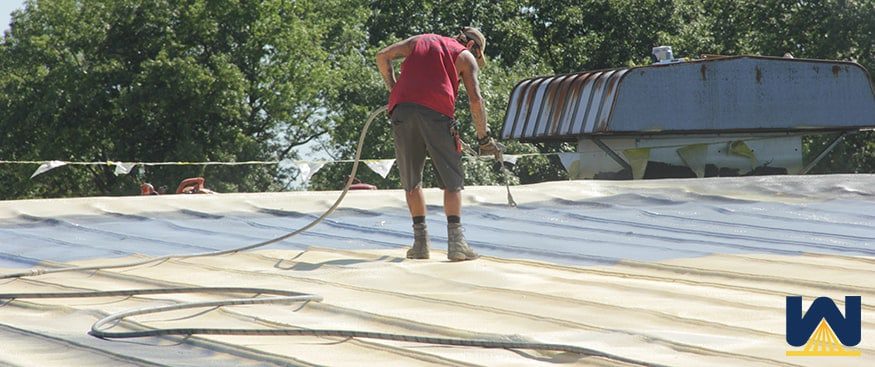One of the most common questions our sales team gets is, “Can a spray foam roof be installed over a metal roof?
The most honest answer I can give is…absolutely!
Some building owners don’t realize that spraying over metal is an option.
If you have a roof leak with your metal roof, installing spray foam over top can close all those leaks and provide you with more R-value.
In fact, spray foam has a 100% chemical adhesion across the entire metal roof. Spray polyurethane foam will mirror the existing metal roof.
Here’s a start-to-finish video of spray foam being installed over an existing metal roof:
What can spray foam do for a metal roof?
The first benefit is that spray foam can close all those little holes that produce leaks.
The second benefit is that spray foam increases your roof’s R-value, or its ability to keep heat in during the winter, and cool in during the summer, which will save you money on your energy bill.
What condition does the metal have to be in to be ready for foam?
For spray foam to stick to any roofing platform, it must be cleaned and completely dry. For metal roofs, we’ll power wash the roof to get all the contaminants off.
If you don’t get all the contaminants off, the spray foam might have a difficult time adhering properly to your metal roof.
In addition, one difference you’ll encounter when dealing with metal roofs is rust.
Obviously, with installing SPF on a rubber or built-up roof, rust doesn’t factor into the job preparation.
To deal with rust, a roofing contractor will use a rust inhibitor primer, which will stop the oxidation process in rusting metals which have been exposed to oxygen and water.
If this step is skipped, rust will continue to grow on your metal roof, which will accelerate the rate of decline in your roof’s projected lifetime.
What if my roof has holes, can I still get a spray foam roof?
Yes.
If there are plenty of small holes (pinhole size), a roofing contractor can spray foam right over top of them. If you have larger holes, a piece of metal will be laid and connected over that area. Of course, any holes that present a structural or safety issue need to be corrected prior to any re-roofing.
We’ve encountered holes the size of school buses on some roofs!
What if my metal roof is currently leaking?
Most of the time, a roof leak is the #1 reason a roofing contractor is called. A spray polyurethane roof can be installed over a leaking metal roof. Since spray foam is monolithic and closed-cell, it will create a watertight barrier over the entire metal roof.
Most of the time, extreme heat shifts cause that leak. Your metal roof expands when it’s hot and contracts when it’s cold.
Over time, the grommets underneath the fasteners will wear out, exposing a small hole in the metal roof.
Will spray foam restrict the thermal movement of the metal panels?
Yes, but it’s no cause for concern.
If you’re unaware, metal panels expand and contract with the weather changes.
Spray foam tends to put the metal roof to sleep so it doesn’t see the extreme heat and cold cycles.
Most of the time, the “shifting” is what causes fasteners and grommets to move, crack/break, and therefore create an opportunity for water to enter the building.
How spray foam over a metal roof stopped a rain parade on a carpet mill
West Roofing Systems built a roof in Cartersville, GA, for a company called Spring Industries, a carpet mill that has a metal roof.
The building had a very high humidity level because of the manufacturing process of the carpet.
Years before West Roofing was involved, a tornado came through and blew the existing roof off the building.
Another roofing contractor installed a new metal roof, but they forget to install grommets on the fasteners.
Over time, the roof began to leak, and the water got into the building and was developing on the insulation on the inside of the building.
Over time the insulation would fall, exposing the bottom of the metal roof. With the humid air rising, hitting the ceiling, and causing condensation, it felt like it was literally raining inside the mill.
Then came a spray foam roof.
During installation, when you walked inside the building, you could look at the water stains on the floor and could tell where we stopped working for the day.
Once 1.75” of spray foam was installed outside the metal, all the exposed leaks were sealed, and the metal wasn’t exposed to extreme temperature change any more.
So, when the humidity rose inside the building and hit the bottom of the deck, due to the normal temperature of the underlying metal roof, there was no moisture developed.
Same humidity, no moisture, no condensation, and no rain on carpets.
The spray foam roof created a leak-free environment on the outside so that normal business operations can be done without interruption on the inside.


